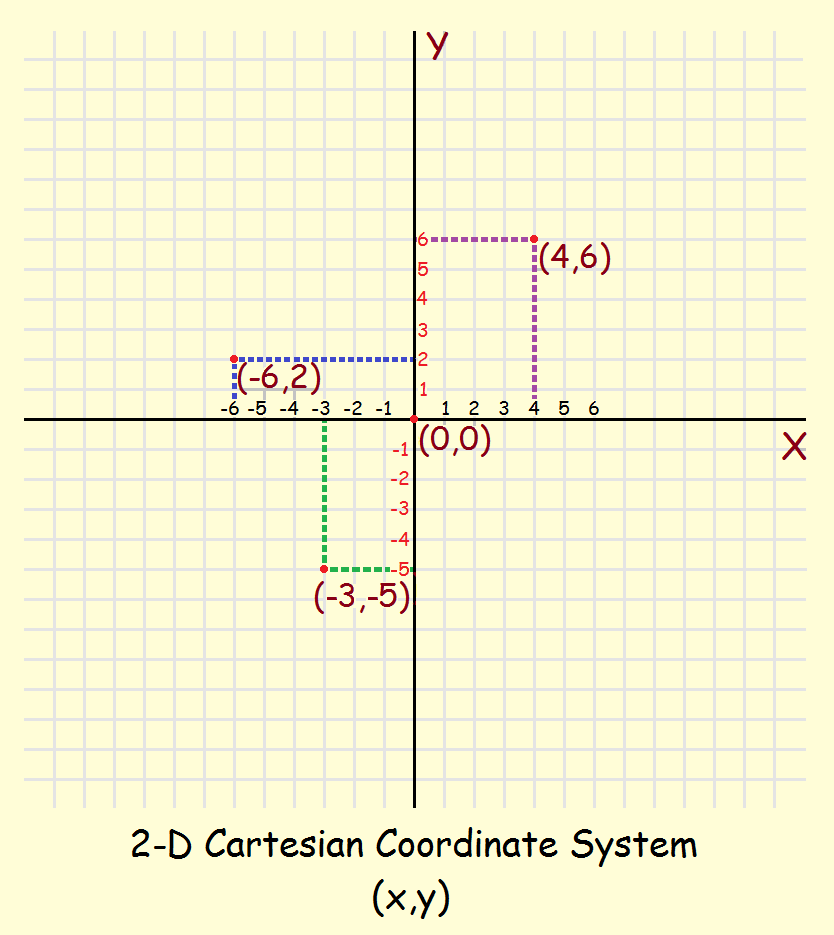 In analytical geometry (usually taught in high school), two lines are drawn on a paper that are perpendicular to each other. The vertical line represents the “y-axis,” and the horizontal line represents the “x-axis.” Using these two axes, every point on the paper can be given a value that defines where the point is. If the place where the two lines cross is the zero point or origin, its coordinates (x, y) are simply, (0, 0).
In analytical geometry (usually taught in high school), two lines are drawn on a paper that are perpendicular to each other. The vertical line represents the “y-axis,” and the horizontal line represents the “x-axis.” Using these two axes, every point on the paper can be given a value that defines where the point is. If the place where the two lines cross is the zero point or origin, its coordinates (x, y) are simply, (0, 0).
Along the horizontal x-axis, starting to the right of the (0, 0) point, write little numbers like a ruler has, 1, 2, 3, and so forth. To the left of that point, write, -1, -2, -3, and so on. For the y-axis, the 1, 2, 3, and such go upward, whereas the -1, -2, -3 and the rest go downwards.
Coordinate Axes: Equation of a Line – Examples
OK. We’ve prepared our coordinate system. Using it as a kind of mapping aid, we will draw the simplest of equations, that of a straight line. What does the general equation for a line look like? Before we discuss that, we’ll first consider three examples. First, the line,
x = 1
This equation means that no matter what value y has, x has the value one. Let’s draw some points to demonstrate what we mean. We’ll pick y = 0, y = 2, y = 5, y = -3. Then, we get
(1, 0)
(1, 2)
(1, 5)
(1, -3)
Locating these on our coordinate axes, we see that all we are doing is drawing a line parallel to the y-axis, but to the right one notch!
Correspondingly, if we next consider,
y = 1
we end up with a line one notch above the x-axis!
For our final example of a line. Let’s choose, y = 2x. Some example points are,
(0, 0)
(1, 2)
(3, 6)
(-2, -4)
(-2.5, 5)
This line goes from the bottom left-hand side of the coordinate axes up to the right-hand side. The line is just a bit more vertical than horizontal. This is because we included the number 2 in the equation. If we had written y = 1/2 x instead, the line would have been a little more horizontal than vertical. It is for good reason that the number in front of the x is called the “slope.” As in skiing, the number determines the slope of the line.
General Equation for a Line
OK. We’re ready to consider the general equation for a line. It is,
y = mx + b
We’ve already seen that m is a number representing the slope of the line. What, then, is b? It determines where the line crosses the y-axis. To demonstrate that, choose x = 0. Then if b = 2.7, for instance, y = 2.7. The line crosses the y-axis at (0, 2.7). This is the reason why b is called the “intercept.” It represents the point where the line intercepts the y-axis.
Note: You might also enjoy Introduction to Cylindrical Coordinates
← Back to Math-Logic-Design
← Home
